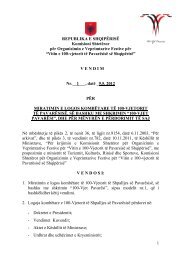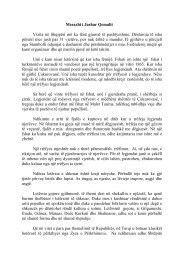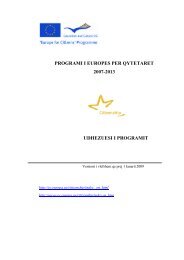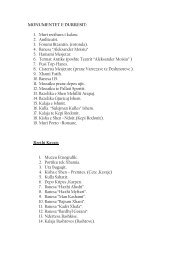Albanian Cultural Heritage
Albanian Cultural Heritage
Albanian Cultural Heritage
You also want an ePaper? Increase the reach of your titles
YUMPU automatically turns print PDFs into web optimized ePapers that Google loves.
Butrint (Bouthrotos) is located in the<br />
southwestern coastline of Albania. The<br />
city is separated by a narrow stretch<br />
from the Greek island of Corfu. The site<br />
has been occupied approximately at the<br />
8th century B.C., but legends hint at the<br />
city’s foundation by Trojan exiles. By the<br />
4th century B.C., a walled settlement<br />
had been established and the city began<br />
to develope through trade. Augustus<br />
founded a colony at Butrint and the town<br />
remained a relatively small Roman port<br />
until the 6th century C.E. Following the<br />
fall of the Roman Empire, the city shrank<br />
in population and significance. Butrint<br />
then entered a turbulent period and<br />
control of the city was bitterly fought by<br />
the Byzantine, Norman, Angevin, and<br />
Venetian states. The Ottoman Turks and<br />
briefly the French disputed later ownership.<br />
By the time it became a part of Albania<br />
in 1912, it was virtually deserted. Various<br />
archeological efforts began in the 1920’s,<br />
and continue today.<br />
VLORA COUNTY<br />
Butrint was declared a UNESCO World<br />
<strong>Heritage</strong> Site in 1992. The ground of<br />
Butrint features an impressive array of<br />
historically significant archaeological sites.<br />
Foremost among them is the theater,<br />
which dates from the 4th century B.C.<br />
hosting approximately 1,500 spectators.<br />
Performances are still staged there at a<br />
summer-festival each year. An impressive<br />
baptistery (with extensive mosaics) and a<br />
basilica from the 6th century C.E. attest to<br />
the various occupations of the city. A canal<br />
and vestiges of Roman courtyard houses lie<br />
near the theater. Additionally, kilometers<br />
of imposing walls surround much of the<br />
site. Nearby, the recently renovated Butrint<br />
Museum houses many fascinating objects<br />
unearthed during the various archeological<br />
digs. One must travel to the National<br />
Historic Museum to view the famous<br />
head of Apollo, unearthed by the Italian<br />
archaeologist Luigi Maria Ugolini during<br />
his excavations in the 1920’s.<br />
55








